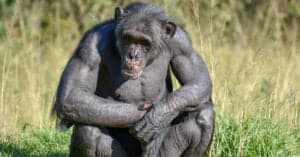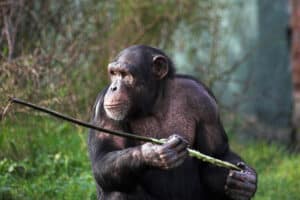Chimpanzees (Pan troglodytes) are giant apes that belong to the same family as humans, the Hominidae. They are our closest relatives, with whom we share 98 percent of our genetic DNA, and can be found throughout central and western Africa. They’re sensitive, forceful, intelligent, and social beings.
While there are many things you may know about chimps, there are other fascinating characteristics you don’t know about them. Here are ten incredible facts about our evolutionary relatives.
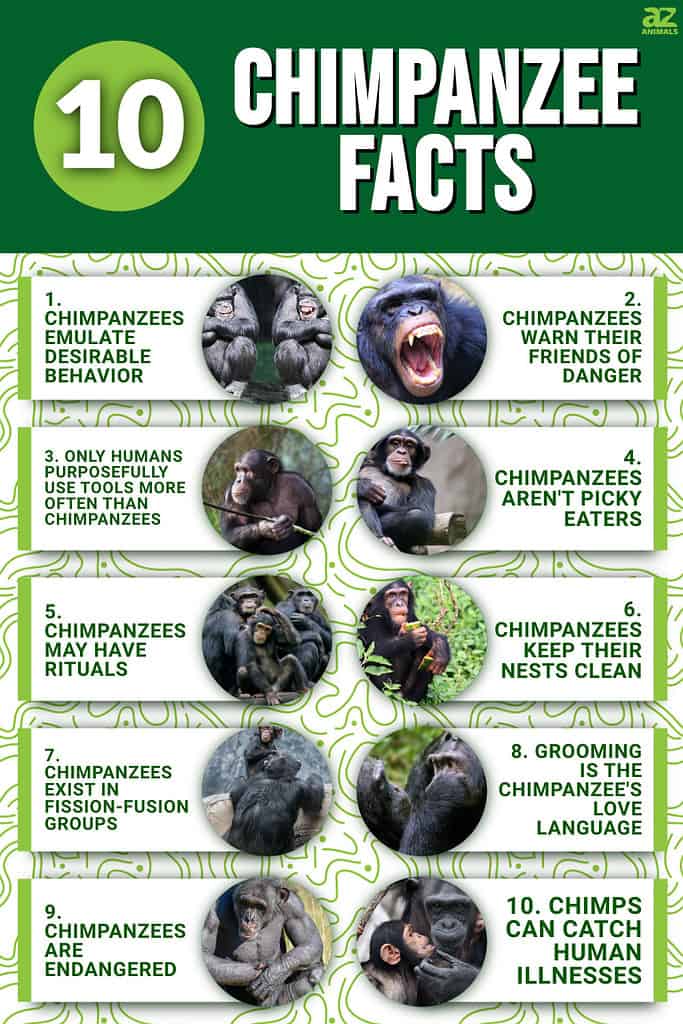
1. Chimpanzees Emulate Desirable Behavior

Chimpanzees have been seen taking fashion advice and learning to create tools from each other.
©abadonian/iStock via Getty Images
In chimps, social learning is ubiquitous. They have been seen taking fashion advice and learning to create tools from each other. In 2010, Julie, a Zambian chimpanzee, once placed a grass stem in her ear for reasons we do not know.
The rest of her friends did the same. A group of researchers observed the conduct but did not find it a recurrent movement. They could not determine the purpose of the ear accessory other than that it must have appeared attractive to the other chimps.
2. Chimpanzees Warn Their Friends of Danger

Chimpanzees make startling vocalizations and stare at a threat before returning their gaze to their clan until other chimps notice.
©Afandi Teguh Afriyanto/Shutterstock.com
Chimps live in hazardous environments, but they always have each other’s backs. Chimpanzees are renowned for alerting their companions, but scientists discovered in a 2013 study that chimps would change their signals based on the information they believed the other chimps had about the situation.
Chimps will make startling vocalizations and stare at a threat before returning their gaze to their clan until other chimps notice. Their utterances and movements become more intense if they perceive that another chimp is unaware. The study also discovered that chimps who are friends or relatives would give more caution regarding risks.
3. Only Humans Purposefully Use Tools More Often Than Chimpanzees

Jane Goodall observed chimpanzees removing the leaves from branches, plunging the sticks into termite mounds, and then taking them out covered in tasty insects.
©Norma Cornes/Shutterstock.com
Jane Goodall was the first to notice chimps manufacturing and utilizing tools in Tanzania’s Gombe National Park in the 1960s. She observed them removing the leaves from branches, plunging the sticks into termite mounds, and then taking them out covered in tasty insects. Further research revealed that the Gombe chimps used twigs or stones as tools for nine distinct tasks.
Other chimps utilize tools in different ways, such as extracting honey from beehives with sticks. In 2007, archaeologists digging in Côte d’Ivoire, West Africa, found pebbles that an old chimp colony had used to crack nuts.
4. Chimpanzees Aren’t Picky Eaters
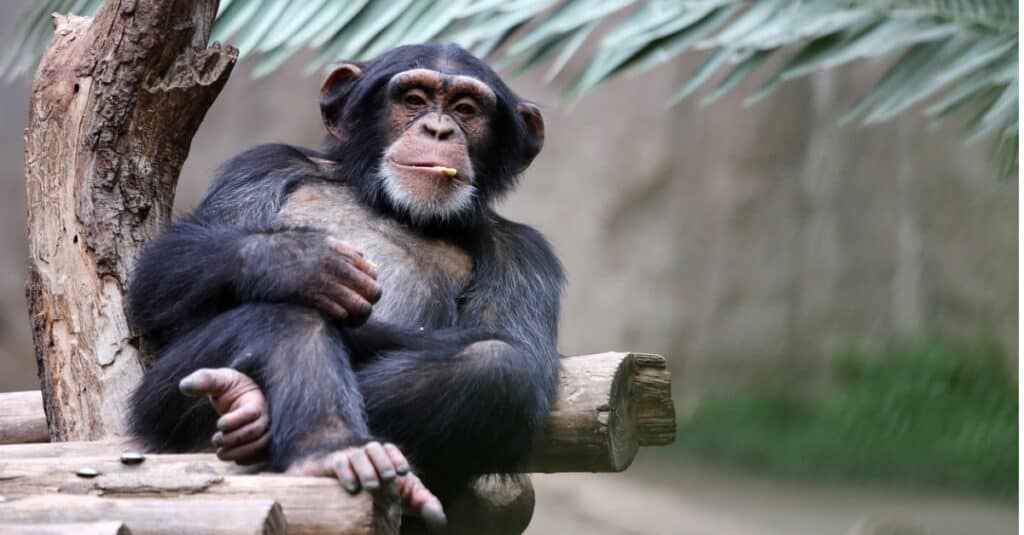
Chimpanzees eat a wide range of vegetables, fruits, seeds, and roots.
©MarclSchauer/Shutterstock.com
Chimpanzees were once thought to be herbivores, but it has now been shown that they are omnivores who eat both meat and vegetation. Chimps also eat monkey flesh, with a preference for red colobus monkeys. The red colobus monkey population has declined significantly in both prevalent regions. When Goodall saw the animals extracting termites with sticks, she realized they were eating something else besides plants.
They eat a wide range of vegetables, fruits, seeds, and roots, but they avoid foods that they find unpleasant, such as foods that smell like biological pollutants.
5. Chimpanzees May Have Rituals
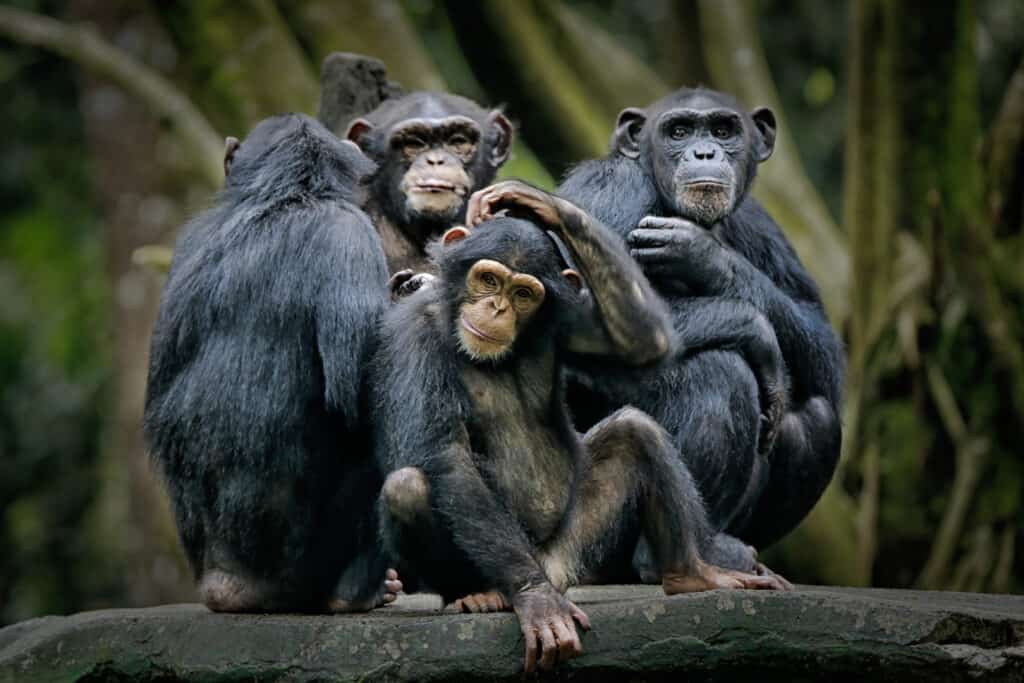
The practice or relevance of chimpanzees throwing stones at trees relevance is unknown, but it does open up a new window into chimp behavior.
©Ari Wid/Shutterstock.com
Four groups of chimps in West Africa were captured on camera throwing stones at or into specific trees, then leaving the rocks there so they could continue the process. The authors speculate that the action is ceremonial; however, they acknowledge that the term “ritual” is debatable in this context.
The throwing exercise featured a pant-hoot vocalization, with most participants being male. The practice’s relevance is unknown, but it does open up a new window into chimp behavior.
6. Chimpanzees Keep Their Nests Clean
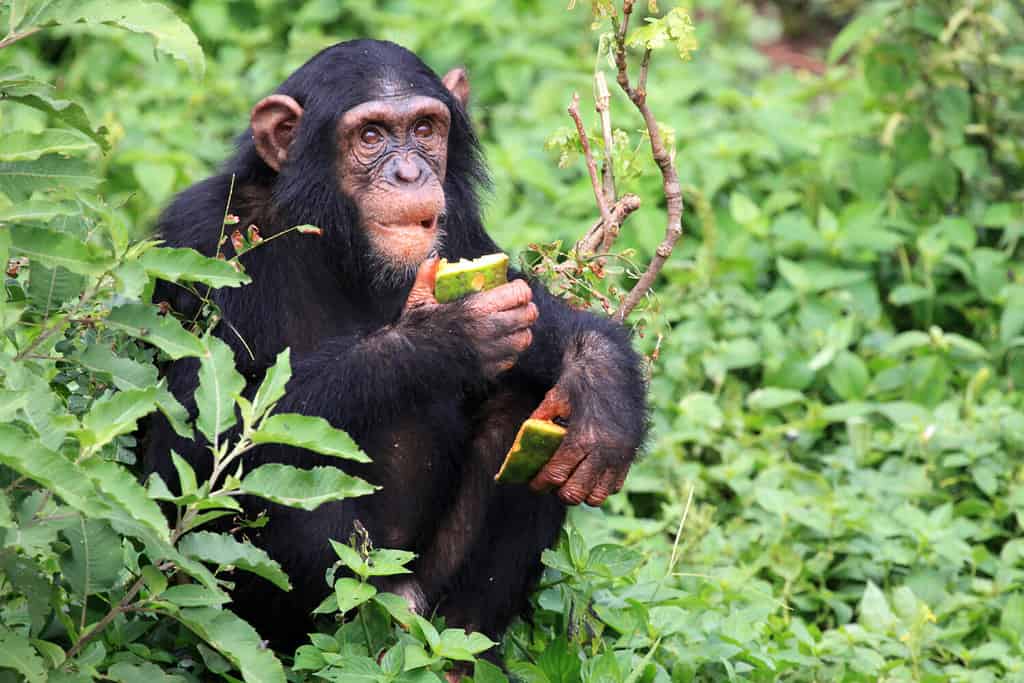
According to a Tanzanian study, chimp nests are less likely to store bacteria than human mattresses.
©Sam DCruz/Shutterstock.com
You probably didn’t know chimpanzee nests were neater than human beds, did you? According to a Tanzanian study, chimp nests are less likely to store bacteria (fecal, cutaneous, or oral) than human mattresses. They build a new nest every night, preventing bacteria from building. The researchers also highlighted that out of 41 nests examined, they only detected four individual parasites. As a result, chimps are resting comfortably in a nest that is practically bug and bacteria-free.
7. Do Chimpanzees Live in Groups?

Chimpanzees exist in fission-fusion groups.
©iStock.com/JeannetteKatzir
Chimpanzees exist in fission-fusion groups, which means their social groupings’ size and composition shift over time. They spend most of their time in “parties,” which are small, momentary groupings of few mates, but they also connect with a larger group known as a “community.”
Although they are rarely seen together in one place, all inhabitants of these multi-male, multi-female societies know each other and collectively protect a common home region. Communities can have up to 150 members, but tight hierarchies exist, with only one dominant alpha male.
8. Grooming is the Chimpanzee’s Love Language
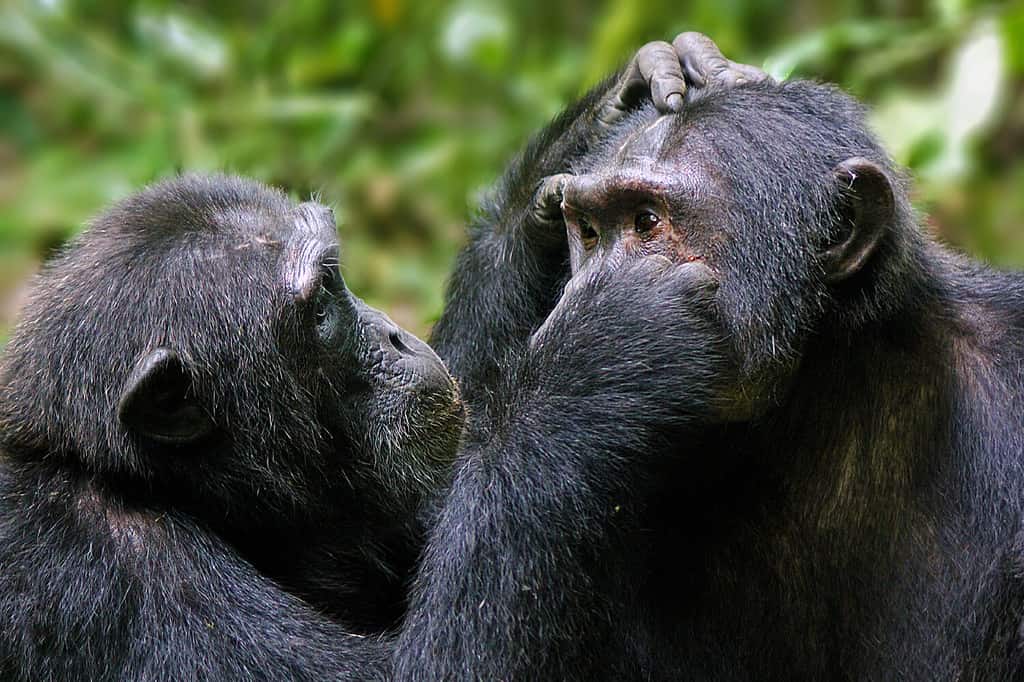
When a low-rank chimp grooms a buddy of the same social standing and notices a higher-rank chimp passing by, the groomer will cease grooming.
©ThomasDeco/Shutterstock.com
When chimps groom other chimps by picking through their fur and removing parasites, filth, and dead skin, it soothes them, keeps them healthy, and strengthens social relationships. Low-ranking chimps groom higher-ranking chimps to receive defense or other social benefits. When a low-rank chimp grooms a buddy of the same social standing and notices a higher-rank chimp passing by, the groomer will cease grooming. It’s possible he doesn’t want to waste time nurturing a friend who won’t provide the same level of social security as the high-ranking observer.
9. Chimpanzees are Endangered
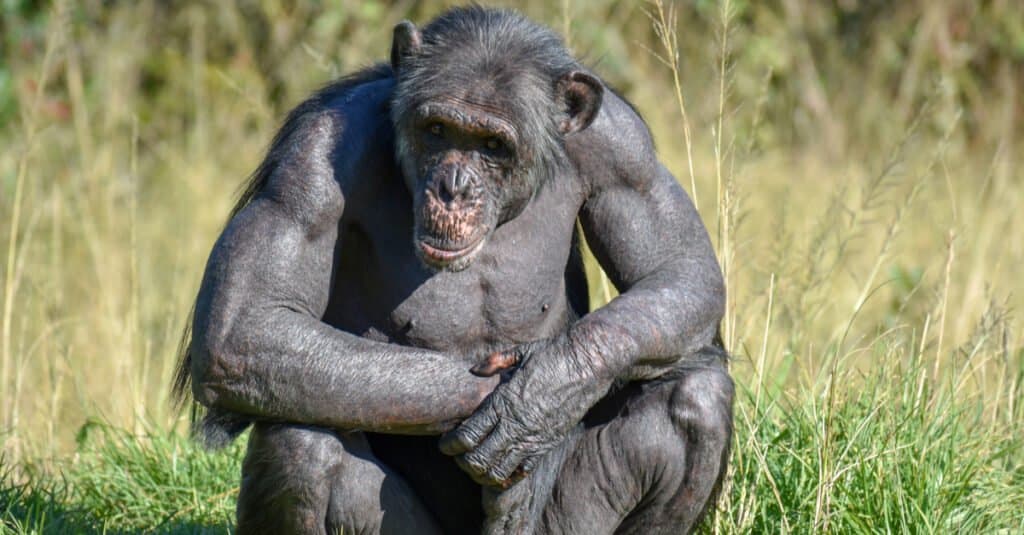
Chimpanzees are critically endangered, and their numbers are declining.
©Darren Hopping-Mills/Shutterstock.com
Chimpanzees, our closest living cousins, are critically endangered, and their numbers are declining. Although it is unlawful to catch, hunt, or consume chimps, hunting is the biggest threat to their survival. The biggest threats to chimps are illegal hunting, infectious diseases, habitat loss, and a drop in the quality of their habitat because of humans.
While the chimp population is protected by law within their territory, law enforcement must do more to safeguard them. Better organized land use control in the chimps’ area is required to protect them from further habitat degradation due to agricultural operations.
Another significant risk for chimps is their vulnerability to infections that affect people due to their human-like characteristics. Chimps who come into contact with humans, whether for tourism or research, are at risk of developing infectious diseases.
10. Chimps can Catch Human Illnesses
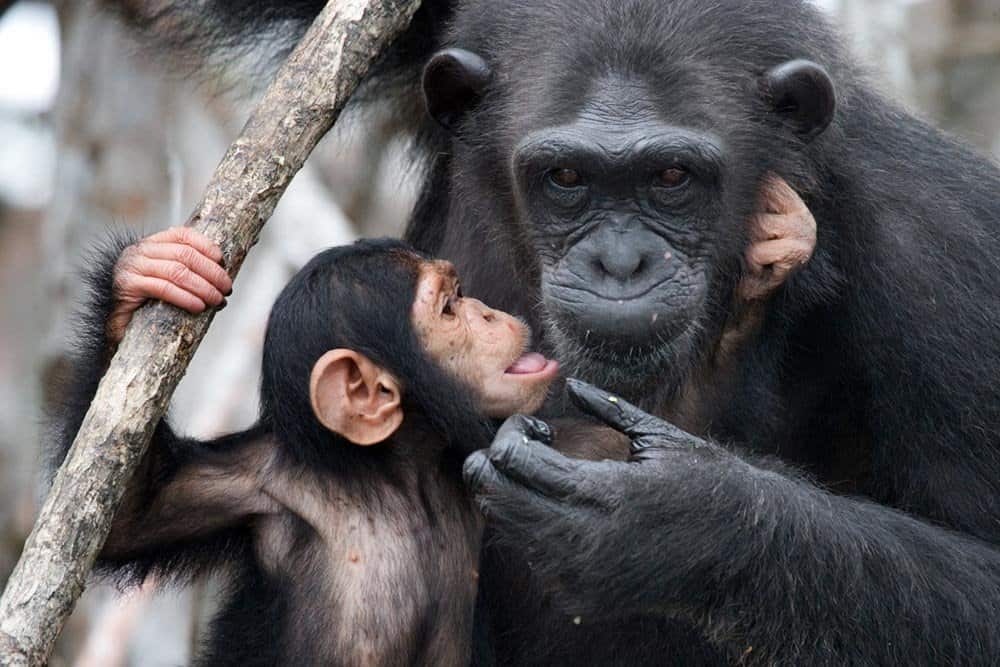
An outbreak of rhinovirus C, one of the most prevalent causes of the cold or flu in humans, claimed the lives of 5 of the 56 chimps.
©GUDKOV ANDREY/Shutterstock.com
In Uganda’s Kibale National Park, an outbreak of respiratory sickness struck a group of chimps in 2013. Researchers found the cause after the body of a two-year-old chimp was retrieved and autopsied: rhinovirus C, one of the most prevalent causes of the cold or flu in humans. The illness claimed the lives of 5 of the 56 chimps.
Because of their rate of extinction and vulnerability to illnesses that affect people, the IUCN and the Primate Specialist Group published security protocols and standards of practice for chimps and other great apes against COVID-19 in 2020.
The photo featured at the top of this post is © Afandi Teguh Afriyanto/Shutterstock.com
Thank you for reading! Have some feedback for us? Contact the AZ Animals editorial team.




